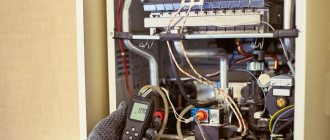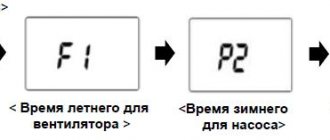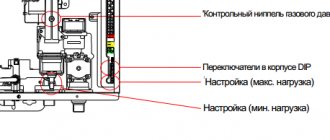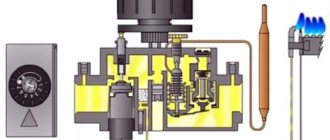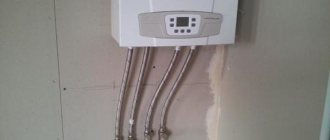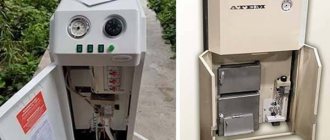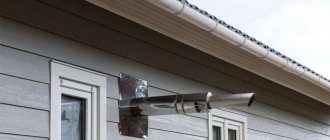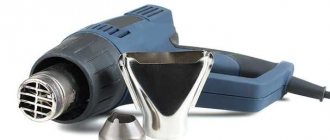Gas boilers from the South Korean company Navien are well known to Russian users.
They have an optimal combination of price and quality and are adapted to Russian climatic and technological conditions.
The cost of Navien equipment is half that of its European counterparts.
The manufacturer made sure that the boilers withstand changes or low pressure of water and gas, and independently compensate for up to 30% of the voltage drop in the electric current network.
Let's look at the setup technology and methods for eliminating the most common errors that occur during the operation of units.
Repair instructions for gas boilers Navien
Basic boiler settings are carried out simultaneously with the initial installation.
Connection is made to all necessary communications and systems:
- Gas supply.
- Water supply.
- Connection of the direct and return pipelines of the heating system (OB, coolant).
- Connection to the power supply network.
- DHW supply system (distribution to distribution points).
The initial setting of the boiler is carried out using DIP switches and a resistor that regulates the gas supply (pressure). They are located on the unit control board.
IMPORTANT!
Self-tuning of Navien gas boilers is strongly not recommended. To perform this procedure, you should invite a specialist from the service center.
How to prevent noise
To avoid the appearance of extraneous sounds during the operation of the fireplace, it is necessary to ensure timely maintenance of heating equipment. It includes lubricating parts, removing carbon deposits and dust, cleaning components and monitoring water levels. It is equally important to control the gas supply so as not to provoke an increase in pressure.
If you do not control the water level in the pipes, noise caused by water hammer may appear. It is caused by the force of inertia, due to which the liquid cannot instantly stop in the pipes.
How to properly adjust and start
Procedure:
- The boiler startup procedure begins with filling with water. Gas dual-circuit units do not need to install additional devices, so you just need to open the make-up valve and increase the pressure to 1.5-2 At.
- After this, the valve is closed, air pockets are removed from the system and on the unit itself, for which Mayevsky valves on the radiators and an air valve in the boiler are used.
- Then you need to bleed the air from the circulation pump. The casing is removed and the water heating controls are turned on. Specific sounds appear, indicating the operation of the system. On the pump, gradually unscrew the screw in the middle until water appears. This procedure must be done 2-3 times, after which the air from the pump will be completely removed.
- As soon as the circulation pump is brought into operation, the burner will start electronically and the heating system will begin to function.
This completes the initial startup and adjustment procedure..
Noise diagnostics
The operation of a boiler with a water heating circuit is often accompanied by noise. It not only brings significant discomfort, but can also be potentially dangerous for everyone in the household. Therefore, it is not worth leaving this problem without a solution.
Before identifying the cause of the deficiency, the nature of the extraneous sounds should be determined. This will help in diagnosis and increase the chances of successfully fixing the problem.
The most common defects of boilers in a fireplace include:
- quiet knocking in the boiler;
- a crackling sound that occurs when the heating system is turned on;
- regular appearance of hum;
- vibration;
- periodically repeating clicks.
All of these signs indicate that the problem needs to be corrected. If you ignore them, the situation may be resolved by a complete breakdown of the entire heating system.
Expert opinion
Filimonov Sergey Vinokurovich
Heating equipment repairman
A loud bang that occurs when igniting may indicate gas accumulation. To avoid undesirable consequences, it is necessary to evaluate the condition of the electrodes, burner and connections.
User manual
Navien gas boilers are operated automatically, with minimal human intervention.
The owner only needs to observe the readings on the display and respond in a timely manner to the appearance of an error code.
In addition, the user determines the operating mode - summer or winter:
- Summer mode is determined only by DHW heating.
- Winter mode starts the heating system simultaneously with the supply of hot water.
The display has a button with a corresponding icon (symbol of a snowflake or sun).
If it is necessary to adjust the extract air temperature or other parameters of the heating system, the winter operating mode must be turned on. Exhaust temperature is adjusted when the radiator icon is flashing.
If it lights up steadily, the display shows the current temperature . By pressing the “radiator” button so that the icon flashes, press the “+” or “-” buttons to change the set coolant temperature.
The icon stops flashing after a while (a few seconds), and the boiler will begin to heat or cool the coolant in accordance with the instructions received.
What happens when hot water is turned on simultaneously at two points of intake
The scheme becomes more complicated if, while using hot water at one point of intake, it becomes necessary to turn it on at another point, for example: when the shower is turned on in the bathroom, it becomes necessary to wash your hands in the toilet washbasin. In this case:
- the rate of hot water use increases sharply, its consumption increases,
- weak pressure of hot water appears;
- the flow of cold water into the boiler increases,
- a drop in the temperature of the boiler heat exchanger leads to the fact that the water temperature at the first intake point ceases to be comfortable,
- a few seconds are required to turn on the boiler automation for heating,
- a few more seconds for both users at two points of collection to be able to use water at a comfortable temperature.
All this time, both users cannot fully use hot water. It arrives intermittently. The unproductive consumption of water, which goes uselessly into the sewer system, increases sharply.
What if one of the users turned off the water? In this case, the consumption of hot water drops sharply. A temperature jump occurs on the heater of a double-circuit gas boiler. As a result, the temperature of hot water increases sharply at the point of intake that continues to operate. The user cannot fully use the water; it goes down the drain until the automation on the boiler is activated and water at the required temperature begins to flow to the user in a stable manner.
Running self-test
The Navien boiler self-diagnosis system operates constantly and does not require a separate startup.
The probability of a failure of one or another node exists at any time, so the sensors send signals about the status of certain elements 24/7, never stopping.
If the sensor stops working for any reason, the corresponding error code immediately lights up on the display. This is an important function that helps maintain performance and timely troubleshooting .
Malfunctions in the Navien Deluxe boiler
________________________________________________________________________________
Can you tell us what the problem is if the Navien Deluxe double-circuit gas boiler turns on and off? How to fix it? We have been using the device for about six months. The flame is not detected by the control unit: the phase and neutral are incorrectly connected. Connect phase and neutral correctly. If this does not bring results, pay for repairs. The ignition electrode cable is disconnected or damaged. Connect or change the electrical wiring. The pressure of the gas mixture is extremely low. Enlarge it. Would you like to know why the gas boiler does not light up? The device was connected this year. What can be done? No ignition. There is no gas supply. Open the gas valve and check the pressure. The distance between the electrodes is not maintained or they are bent. Insufficient electrode spark discharge. There is probably a problem with the input power. For some reason, after turning on the gas boiler, a strange noise may be heard, and then the gas burner unit begins to go out. An error appears on the monitor indicating overheating. We are recommended to change the heat exchanger. What should I do? Stopping the operation of the device due to overheating of the coolant depends not only on clogging of the heat exchanger. Strange noises can also occur when there is excess limescale on the heat exchanger fins, and when there is a lot of air in the heating circuit. Although initially you need to check that the overheating sensor, three-way valve and circulation pump are functioning properly. Can someone explain why the Navien Deluxe wall-mounted boiler goes out? There is a problem with flame detection. Reduced gas pressure. Interruption in the supply of gas mixture. Gas valve failure. Defects in the parts of the ignition device or their electrical connections are damaged. However, the control board may be faulty. Please explain why the gas boiler turns off? What to do? We have been using the unit for about six months. The reasons for shutdown are incorrect power of the device, low gas pressure, problems with the smoke exhaust duct, power surges, and failure of the automation. Can someone explain what the problem is if the water pressure drops in a gas boiler? The device was launched last year. What could be wrong? Presence of air in the heating circuit. The air bleeder is damaged. It needs to be changed. The heating system filter is clogged. Clean the filter element. There is a leak in the boiler or heating pipes. Failure of the make-up valve. Problems with the flow switch. Test and change if necessary. The circulation pump is faulty. Reduced rotation speed due to wear on the impeller. Could you please explain what is the cause of the problem if the Navien Deluxe 13K boiler does not turn on? What could be the reason? A long period of ignition of the gas burner device indicates a clogged ionization flame sensor. In order to eliminate the malfunction, you need to clean the sensor and turn on the unit again. Traction sensor malfunction. The supply of gas mixture to the burner block stops. The sensor must be cleaned or a new one installed. Maybe someone can tell me what is the reason for the malfunction if the boiler does not heat? What is the problem? We have been using the unit for about six months. Check the heating circuit filter. If the filter is clogged, disassemble and clean the filter element. The impeller of the hydraulic circulation pump is damaged. Inspect the hydraulic pump and replace if necessary. In addition, check the circulation of coolant in the heating pipes. Wear or clogged heating lines can reduce the amount of liquid in the system, causing the unit to operate unsatisfactorily in heating mode. I can’t figure out how to fill a double-circuit boiler? This operation must be carried out according to a certain scheme. Open the air valves on the radiators and monitor the operation of the air removal valve supplied with the boiler. Slowly open the feed tap, observing the stability of the functions of all air removal components of the heating system without exception. Close the air vent valves on the radiators as soon as water is visible. After this, close the make-up valve and bleed the air again using the valves on the radiators. Turn on the unit and wait for it to heat up to the set temperature in the heating line, then turn off the pump and remove air again. What is the reason for the malfunction if the Navien Deluxe Coaxial 24K boiler makes clicking noises during heating? In particular, the gas burner device begins to flare up, the temperature begins to increase, and strange metallic sounds are heard. Although if you unscrew the bolts holding the outer cladding, then there is no jingling. What it is? It happens that the device begins to produce a roar, knocking and hum, mainly when the function of the main burner device is interrupted. The key reason for this complication is disproportionate heating of the heat exchanger fins, due to blockages or calcium deposits. You should clean the heat exchanger soon. Why doesn't the boiler turn off after it reaches the set temperature? Heating continues up to 90C, after which it fails. If I reset, the problem reappears. Perhaps the electronic board is not in order, the boiler water temperature sensor is damaged, or the protection sensor button is faulty. It cannot be ruled out that there was an error in the operation of the automation. Can you tell me how to reduce the pressure in the Navien Deluxe Coaxial gas boiler? And is it allowed to reduce the gas pressure? Is there a regulator there that equalizes the pressure of the gas mixture, or should they not make this adjustment? The regulator should be used to adjust the fuel pressure entering the device. If it is quite reduced, the burner unit will not flare up when increased, then it is possible that the fire will separate from the wick, and the gas burner device will go out soon after ignition. Here are the adjustment operations. Heat the device intensely. Fully open the chimney duct. Set the main burner to the maximum setting, the flame appears yellow-blue. By turning off the supply valve, we minimize the yellow tint of the flame. Afterwards, test the operation of the device in all modes. There is a tap at the bottom of the boiler, from which water often leaks. The unit itself does not start. What to do? Most likely, the coolant is discharged from the valve of the protection group. This factor indicates increased pressure in the system. The system filling valve may also be open or it is recommended to pump the expansion tank. Please tell me, what is the problem if the pressure constantly increases and the relief valve comes into operation? The display always shows the heating icon during the boiler heating cycle. What's happened? There is a problem with the heating circuit temperature sensor. Stopping the corresponding circulation process in the heating line. A few days ago there was trouble with the Navien Deluxe Coaxial boiler. It whistles while working. I tried to reboot it - the attempt was successful, but it still whistles. Perhaps someone can tell why this is happening? In many cases, a loud whistle occurs if the pressure on the nozzles of the gas burner device is not adjusted according to the instructions. We recommend checking the gas pressure adjustments and correcting them if necessary. After 2 years of proper operation, an incomprehensible problem arose. When the heating mode is turned on, the pressure increases sharply during heating, and an emergency discharge of water is noted. Tell me, what is the reason? There may be damage to the expansion tank membrane or lack of air in the air chamber. It is also possible that the 3-way valve may break. The unit could hum when starting up before, but now the noise has become stronger. Initially, the sound occurred periodically, but now it can be heard for much longer. I haven't heard it for long, have you seen this problem? The occurrence of extraneous noise can be explained by the presence of mineral deposits inside the heat exchange device, which should not be heated equally due to different wall thicknesses. The more clogged the heat exchanger is, the louder the noise is, and the heat transfer decreases. I plan to connect the Navien Deluxe Plus boiler to the heating system. Please tell me how to properly put such a unit into operation? To correctly commission the boiler apparatus, certain actions must be taken. Turn on the electrical power of the device. Set the gas valve open. Then we turn on the gas burner equipment. Next, set the desired temperature. Tell us how to clean the cold water filter? First, drain the hot water circuit. Second, unscrew the nut of the flow sensor. Then we pull out the sensor along with the filter from the socket. After removal, clean from impurities and dirt. Why does the Navien Deluxe gas wall-mounted boiler stop heating up? water? The water coming out of the tap is very warm. Can you explain what's going on? Problems can be detected in the following areas. For example, there is a problem with the hot water temperature sensor; the sensor must be replaced. There may have been a failure in the water heating device’s power adjustments. Can someone tell me how to fix a problem with a chimney pipe? Soon it will be the second day since a reverse draft occurs, due to which the smoke began to flow straight into the room. The chimney was made by me myself. It is a steel pipe. Perhaps there was a mistake somewhere. An important reason may be an incorrectly manufactured chimney pipe configuration. There may be soot deposits on the pipe walls, which greatly reduces its functionality. In addition, it is imperative to control the hood in the house.
________________________________________________________________________________
________________________________________________________________________________
- Weller boilers - Diagnosis of main faults
- Malfunctions in Vaillant geysers - Diagnostics and repair methods
- Gas boilers Kiturami World - Diagnosis of possible problems
- Troubleshooting the Proterm Leopard boiler
- Basic errors of the Thermal boiler
- Causes of problems with a Haier geyser
- Helios boiler breakdowns - Causes and solutions
- Ferroli Fortuna boiler malfunctions - Diagnostics and repair
- Beretta City boiler error codes
- Failures in the gas water heater Neva Comfort - Causes and solutions
- Immergas boiler errors and their elimination
- Chaffoteaux Pigma boiler problems - Causes and repair methods
- Possible breakdowns and adjustments of the Fondital Antea gas boiler
- The Neva Lux boiler gives an error code 03, what should I do?
- How to fix an error with code F1 on the Proterm Medved boiler?
- There is an error with code E2 on the Royalthermo Aquarius boiler, how can I fix it?
- How to reset the error code F1 on the Señor Duval boiler?
- Beretta City boiler error codes
- Geysers Ladogaz - Diagnosis of failures and methods of elimination
- Malfunctions during operation of the Biasi boiler
________________________________________________________________________________
________________________________________________________________________________
- Breakdowns during operation of Navien Ace boilers
- Troubleshooting Inse geysers
- Breakdowns in the Viessmann Vitopend gas boiler - Check and repair
- Immergas boiler errors and their elimination
- Causes of breakdowns in the gas water heater Neva 3208
- How to troubleshoot a Chaffoteaux Alixia gas boiler
- Errors in Bosch 6000 gas boiler
- Gas water heaters Baxi - Troubleshooting methods
- Possible malfunctions and adjustments of Haier boilers
- Daewoo gas boiler errors
- Problems with geysers Neva Lux 5611
- Problems with Mizudo boilers - Diagnostics and solutions
- Monlan boiler problems - Causes and solutions
- Mizudo gas boiler error codes
- Malfunctions of the geyser Electrolux GWH 350
- Error A04 on the Beretta City boiler, what should I do?
- There is an error with code E6 on the Hephaestus boiler, how to fix it?
- How to eliminate error code 16 on the Navien Ace boiler?
- The Termica boiler gives an error code E8, how to fix it?
- The Thermon boiler has an error with code E06, what should I do?
- Rinnai boiler errors - Troubleshooting and solutions
- Oasis boilers - Typical faults and repairs
- Hubert boiler error codes
- Causes of problems with Rinnai gas boilers
- Problems during the operation of Halsen geysers
- Rocterm boiler faults and repairs
- Viessmann Vitopend boiler error codes
- The Tiberis boiler shows an error with code E2, how to fix it?
- Error E9 on Bosch 6000 boiler, what to do?
- How to eliminate error code F37 on a Ferroli boiler?
- How to eliminate the error with code 4C on the Buderus Logomax boiler?
- Thermex gas boilers - Basic faults and their elimination
- Gas water heaters Selena - Elimination of possible breakdowns
- The main mistakes of Royalthermo boilers
- Thermona boiler malfunctions - Causes and repair methods
- Error codes for Saunier Duval boilers
- Breakdowns in Ariston Superlux geysers
Basic error codes and their interpretation
Let's look at what error codes may appear on the unit display:
| Error code | Fault type |
| E01-02 | Lack of coolant in the system (flow sensor malfunction) |
| E03 | No flame |
| E04 | False evidence of the presence of a flame (spark breakdown to the sensor) |
| E05 | Exhaust temperature sensor break |
| E06 | Exhaust temperature sensor short circuit |
| E07 | Broken DHW temperature sensor |
| E08 | Short circuit of DHW temperature sensor |
| E09 | Fan failure |
| E10 | Malfunction of the smoke removal system |
| E13 | Short circuit of the OM flow sensor |
| E15 | Malfunction or failure of the control board |
| E16 | Exceeding the permissible boiler heating temperature |
| E18 | Smoke sensor overheating |
| E27 | Short circuit or break in the air pressure sensor |
The appearance of most errors is accompanied by a shutdown of the boiler, which is dangerous in winter, so you should respond to them as quickly as possible.
Use a water heater
A water heater embedded in the hot water supply circuit acts as a buffer tank. Its purpose is to equalize the temperature of hot water and smooth out possible temperature surges. The storage water heater and the gas boiler heater are set to the same operating temperature.
Even if the hot water taps are turned on simultaneously at different points of its intake, all users will initially receive water from the storage tank. The time spent waiting for a comfortable water temperature is reduced. Unproductive water consumption is reduced.
Turning the hot water supply on and off at any point of intake causes a temperature difference in the water leaving the gas boiler. However, this water enters the lower part of the water heater, and when it leaves the upper part, the temperature jump is completely smoothed out.
Connecting the water heater through a ball valve allows you to switch to a conventional gas boiler operating system at any time, which can ensure uninterrupted hot water supply in the event of a water heater failure.
Using a bypass jumper with a tap in close proximity to the boiler allows you to exclude the boiler from the hot water supply system. If the boiler is under maintenance, using the existing water heater will ensure uninterrupted operation of the hot water supply system.
Common malfunctions and their elimination
Let's look at the main ways to eliminate errors that have arisen.:
E 01-02
This error indicates overheating of the equipment due to the lack of coolant in the system. The solution to the problem is to clean the pipelines or check the pump. Alternatively, it is necessary to remove air from the system (primarily from the pump).
E 03
The functionality of the flame sensor is checked. Cleaning ignition electrodes.
It is also necessary to check the presence of gas in the line or cylinders.
E 05
A malfunction of the temperature sensor can be eliminated by checking its condition. The resistance of the sensor is measured at a certain temperature. If the readings correspond to the standard ones, it is necessary to clean the contacts.
If the sensor readings do not correspond to the table values, replacement with a new, functional unit is required..
E 09
First of all, you should measure the resistance on the fan windings, which should be 23 Ohms.
Check if there is power supply at the terminals. If serious problems are detected, the fan is completely replaced.
E 10
Most often, the problem lies in the sensor itself. It is necessary to check its condition, clean the contacts, and replace it if necessary.
E 13
The flow sensor often gets stuck due to clogging of the actuator with small debris, lime deposits, etc. If cleaning the sensor does not give the expected result, a possible breakdown to the control board is checked.
If there is no result, the sensor is replaced.
E 16
Overheating of the boiler can have several reasons, the most common of which is clogging of the heat exchanger and poor flow of the coolant. The protection is triggered at 98°, the alarm is switched off when the boiler cools to 83°.
There are two ways to solve the problem - first you should clean (in difficult cases, replace) the heat exchanger; if there is no positive result, replace the sensor.
E 18
Overheating of the smoke exhaust sensor occurs when the chimney is blocked . The cause may be condensation freezing, strong winds from outside, or foreign objects or debris getting into the chimney. If eliminating interference with the output of combustion products does not bring any results, the sensor should be replaced.
E 27
Lack of air pressure when the fan is running most often indicates a clogged air duct or the need to replace the sensor . Most often, the reason lies precisely in this, since the entry of foreign objects into a closed air channel is extremely difficult.
Reasons for the appearance of extraneous sounds in various models
Some boiler models are characterized by certain malfunctions that cause cracking and humming.
For example, Navien devices may fail due to sediment on parts from circulation or problems with the coolant. To eliminate the malfunction, it is necessary to disassemble the equipment and clean the heat exchanger. In some cases it may need to be replaced. They also check the taps and lower the water temperature, if necessary.
Owners of Beretta brand boilers may encounter scale formation, poor heat transfer in the heat exchanger and errors in pipe connections.
Conord brand products suffer from increased load in cold weather. This is because the manufacturer claims the boiler’s power is greater than it actually is. If the documents say 13 Mbar, then in practice the figure is 10 Mbar. Therefore, it is not recommended to set the equipment operation to the maximum level.
The boiler needs to be cleaned annually.
For the Baksi brand, the boiler cracks more often when heating hot water. It is necessary to clean the valve and ensure that it is adjusted correctly.
Vaillant equipment is characterized by noise when the heating is turned on and the fire is turned off. The reason for this may be a dirty heating circuit filter. This may also be due to a faulty bypass valve. In the first case, cleaning is sufficient; in the second, adjusting the part is enough.
The Ariston boiler often cracks due to problems with air circulation. It is necessary to blow out the heat exchanger using a compressor.
Extraneous sounds during operation of Arderia equipment occur when there is a failure in the pump settings. They need to be adjusted or the part replaced.
Why does blood pressure drop?
The cause of a drop in water pressure in the system can only be a leak. At the same time, it can be both in the boiler itself and outside it - in pipelines, radiators, etc.
It is necessary to open the feed valve, start the boiler and carefully inspect the entire system, step by step. If no leaks are found, the boiler must be inspected. When looking for the cause, you should be guided by the rate of pressure drop.
Perhaps the water goes into the expansion tank, in which the membrane has ruptured. Another reason could be a worn safety valve. If it is connected to the sewer, the leakage will not be noticeable.
NOTE!
In any case, the drop in pressure indicates that it is going somewhere. It is necessary to find the leak, otherwise it may get wet and destroy the structure of the house.
Other faults
There are also malfunctions in the operation of the boiler, during which information about the malfunction is not displayed on the display. The boiler does not turn off after reaching the set temperature. This happens most often in cases where the heated room is poorly insulated and all the heat goes outside. In addition, you can try changing the modulation value and thereby changing the minimum power.
Flushing the heat exchanger
Loud noise can occur when there is a large amount of scale in the heat exchangers. The remedy is to remove the heat exchanger and clean it. Insufficient water heating can also be caused by this reason.
During normal operation of the boiler there is no hot water in the taps. This may be caused by a faulty three-way valve. The average valve service life is no more than 4 years. As a rule, repairs and cleaning do not give results; replacement is needed.
In conclusion, we suggest watching a video about the most common errors of Navien boilers:
Reasons for increased pressure
An increase in pressure in the boiler is primarily demonstrated by the safety valve, which begins to release excess pressure. This problem often confuses even experienced specialists.
The reason lies in the secondary heat exchanger. Hot water is heated from the already heated heating agent, receiving energy in a plate secondary heat exchanger. Both liquids exchange thermal energy without mixing with each other.
But, if a fistula occurs, allowing water from the hot water system to penetrate into the heating system, the pressure will increase and tend to balance with the higher pressure of domestic hot water.
If such a problem occurs, the secondary heat exchanger should be replaced, since repairing it is complicated and ineffective.
Why are the radiators cold when the boiler is running?
Low efficiency of the heating system can be the result of malfunctions of both the circuit itself and the main heating element. In the case of a heating device, it is necessary to pay attention to the three-way valve, the functionality of the pump and the technical condition of the heat exchanger. Typical problems for heating wiring are a clogged filter, insufficient power of the circulation pump and lack of slope of the pipes of the circuit with natural water circulation.
During the operation of a double-circuit gas boiler, each user will encounter certain problems associated with the operation of the hot water supply circuit. These problems are inevitable. They always appear, regardless of the manufacturer of the boiler and its heat exchanger, or the design features of the boiler; it does not matter whether the boiler is wall-mounted or floor-standing. Often the boiler begins to heat hot water poorly or not heat it at all. Especially when you use several points at the same time. In this article we will talk about how to get rid of this problem forever.
Power-on problems
There may be several reasons for such a malfunction.:
- There is no voltage in the network (or it has decreased too much, it has become less than 150 V).
- No gas.
- The boiler is blocked by a protection system that was activated due to a critical error (overheating above 98°).
Other reasons for failure may also occur . First of all, you should check the voltage in the network.
The boiler is capable of compensating for fluctuations of up to 30%, but with more significant changes, it simply will not start. You can solve the issue by using a separate outlet and installing a stabilizer.
If all possible causes have been checked and eliminated, but the boiler continues to be silent, you should invite a specialist . Perhaps the cause was a failure of the control unit, a breakdown, or another serious problem.
You should not attempt to resolve the issue yourself; this may cause the final destruction of the unit.
Use an expansion tank
In winter, when the boiler's heating circuit is activated, any activation of hot water results in the heating circuit being turned off so that the hot water supply circuit can turn on. In the summer, when the boiler's heating circuit is not activated, each turn on of the hot water leads to the gas boiler turning on.
Often the user opens the hot water tap to simply rinse his hands. The boiler turns on or switches, hot water flows through the pipes. But the user may simply not wait for it, washing his hands with cold water.
Meanwhile, frequent and useless turning on and switching of the boiler “eats up” its operating life. A possible solution is to install a small expansion tank. It is installed in front of the water heater. If there is such a tank, for the first time after turning on the tap, hot water enters the pipe exclusively from the water heater due to the increase in pressure in the tank. Thus, in case of short-term use of hot water, there is no need to turn on and switch the boiler.
It is recommended to use a tank designed for hot water supply. Using a tank intended for heating will cause an odor because its membrane is made of rubber.
Doesn't start for a long time
The boiler is started when certain conditions are reached. If the temperature or pressure of water (OB, DHW) is within the specified range, heating will not start until it cools down .
A possible cause may also be partial clogging of the water filter, which slows down the flow and changes the circulation mode. It may be difficult for the circulation pump to operate if it is clogged with lime deposits or small debris.
Download instructions
You can download the instructions here.
Sequence of actions for removing a three-way valve.
- To begin, unfasten the latches on the panel at the top, unscrew the two screws from the bottom and remove the cover.
cover latches
The most important inconvenience is that the valve is “hidden”; it is located in the lower corner at the rear wall of the case, behind other parts. Therefore, some of them need to be removed and then put back together without mixing anything up.
cover removed
And in order not to forget where each part comes from, you can film the disassembly process or take written notes so that, if necessary, you can review and clarify all the nuances, and there are many of them.
- Turn off the boiler completely, turn off the taps and drain the liquid. We completely unscrew the black plug from the bottom of the boiler [drain plug - approx. editors]. Otherwise, we will not be able to remove the pump later.
plug on the bottom panel
You need to remove the filter by unfastening the fixing key and pulling it down. And the remaining water flows from here.
bracket/key
filter
If this is not done, then after disconnecting the pump, water will flow into the housing.
water in the housing
- We unscrew the outermost heating pipe [heating water outlet (supply) - approx. editors]. It is precisely attached to the hole of the three-way valve.
pipe
valve hole
- We remove the pump. First we disconnect the wires.
the wire
Unscrew the 4 screws on the outside of the lower part of the case.
cogs
Unscrew the nut at the place where the pipe is attached to the pump.
screw
The most important thing is not to lose the rubber gaskets, one of which falls out of the nut.
rubber bands
Next you need to pull out the metal plate at the location where the second output is attached.
bracket
It fits like a bracket into special holes and serves as a clamping clamp. Now you can freely pull out the pump.
- Open the three-way valve. To do this, unscrew the bolts from the bottom of the body, where the lower part of the valve is brought out.
bolts
Then we free it from the clamps. Using a screwdriver, each of them just needs to be pulled towards you.
Then, slightly rocking the valve itself, lift it up a little, and it comes out. Unscrewed plate with nipple [heating water outlet (supply) - approx. editors] remained in the opening of the housing. We take it out too.
valve without nipple
- All that remains is to disconnect the wire connector by simply pressing on the retaining plate. That's it - the old valve is completely removed.
What to do if the aspirated air leaks?
For the Atmo model range with an open (atmospheric) burner, the primary heat exchanger is made of copper.
The appearance of a leak is almost always associated with its destruction. Purchasing a new heat exchanger is not an easy and expensive task, so most often the issue is solved by soldering the fistula .
To carry out repairs, you should contact a technician from the service center, since this requires a qualified specialist who can dismantle the unit, find the fistula that has arisen, solder it properly, simultaneously rinse the heat exchanger and install it in place without damage.
The work is complex and requires the participation of a trained person.
Sequence of assembly of all parts.
- To install a new valve without additional disassembly of other parts of the boiler, you need to unscrew its lower part. Place this nipple [heating water outlet (supply) - approx. edition] into the housing seat, and then attach the rest of the valve. That is, in the reverse order as it was when removing the old one. Otherwise, when fully assembled, the valve will not squeeze through diagonally, and some parts may be broken.
- One more thing. The new valve kit does not include a pipe. Therefore, we unscrew it from the old one and screw it onto the new one.
pipe on the valve
- Now we connect the valve to the upper pipe, lifting it a little, and then we connect the side outlet and seat the lower one. We fix it with bolts from the bottom of the boiler body. Carefully insert the wire and connect it to the connector.
wire connected
- We install the clamps to secure the valve in place. The upper one has two parts of different diameters: one larger, one smaller. And here it is important not to get confused: the wider part should be located at the top. After clicking, turn the clamp and check that it sits evenly.
top clamp
The lower clamp is easier to install. You just need to put this bracket on the side exit, and it secures the connection.
lower clamp
- When installing the pump, do not forget to replace the rubber gaskets on both outlets, otherwise there will be a leak.
- Then we tighten the nut securing one outlet with a wrench and insert a bracket that secures the pipe at the second outlet. If you cannot feel and get this bracket into the corresponding grooves, then it is better to remove the pump again and see where these holes are located.
holes for the bracket in the pump
- We insert the wire from the pump into the remaining connector, connect the pipe to the water outlet from the bottom of the boiler and everything should work.
- You also need to insert the plug from the bottom of the boiler and tighten it until it stops. And also return the filter to its place. It is simply inserted and secured with the appropriate bracket.
- All that remains is to power the boiler, let in the water, and top it up using the water supply pin [feeding tap - approx. editors]. We monitor the increase in pressure and check for leaks. We turn on the gas supply and turn on the boiler, setting the required water temperature. You can hear a characteristic noise, this is the air being released. Close the lid and secure it with two bolts from the bottom and two latches from the top.
That's all - everything works properly and without leaks.
Advantages and disadvantages
The advantages of Navien Ace boilers include:
- The optimal combination of price and quality.
- Environmentally friendly process.
- Simplicity and convenience of adjustment and configuration of operating modes.
- Adaptation to Russian conditions, ability to work on unstable gas pressure, water pressure, and power supply voltage.
- Simultaneous provision of heating and domestic hot water.
- Long service life without service checks.
The disadvantages of Navien Ace boilers are:
- Dependence on the availability of electricity, gas and water.
- High noise level.
- Only original spare parts are suitable for repairs.
- The structure is not resistant to hard water.
Most of the shortcomings are not the result of errors or defects during assembly, but rather relate to design features.
They are inherent in almost all gas boilers, regardless of the manufacturer. To prevent the formation of lime deposits caused by excessive water hardness, use electromagnetic softeners or other types of appropriate equipment.
Repair
Even such reliable equipment as a Navien gas boiler can fail for a variety of reasons. Knowledge of how to repair it is necessary even if the owner will not do anything with his own hands, because monitoring the work of specialists is also very useful. In addition, many shortcomings in the operation of equipment can be eliminated with simple steps. Some of them have already been discussed before. You should never take measures that the instructions do not mention, even if they are not expressly prohibited.
When error No. 1 appears, you should:
- carefully inspect the pump and check the impeller;
- assess the condition of the electrical part;
- clean dirt from the filter;
- remove excess air.
It is sometimes possible to correct the situation with the “02” signal by opening the closed distribution valve. It can also be very useful to clean the flag on the sensor. As for cleaning a clogged flame sensor, it is done with fine-grain sandpaper. Error “10” is often eliminated after checking and debugging the contacts in the meter tubes, as well as when cleaning the chimney.
To eliminate the risk when filling the system with coolant, you need to do this:
- Before refueling, disconnect the appliances from the current and turn off the gas;
- After checking the position of the valves, open them all the way;
- open the feed tap to the left;
- close it as soon as the pressure gauge registers a pressure of 1.5-2 bar;
- when emergency devices are triggered, it is necessary to drain the water and do everything from scratch.
Additionally, it is recommended to reduce the heating temperature of the liquid and find out whether the power of the installed boiler is excessive
Important: in the event of any problem, even persons with specialized education are prohibited from interfering with electronic circuits. Spare parts used for replacement, even minor ones, such as a three-way valve, must be purchased only from official dealers of the South Korean company
Before opening the lid, you should stop the supply of not only electricity, but also gas and water.
The fan is replaced in the following order:
- the gas supply line is turned off;
- the hose connecting the fan and the air sensor is removed;
- disconnect both connectors that connect the device to the control system;
- unscrew 3 screws and remove the fan;
- install a new unit (or return the old one after servicing);
- repeat all the operations just described in the opposite sequence.
They begin to change the main heat exchanger, removing:
- a pipe through which gas is supplied;
- transformer that adjusts the current for ignition;
- fan;
- Excessive heat detector.
When all these parts are dismantled, the grounding is removed, the firebox and smoke collector are removed. The next step is to unscrew the screws holding the firebox cover and connecting the heat exchanger with its body into one piece. After replacing the device, all manipulations are repeated in exactly the same way, but with the opposite sign, and the boiler turns on.
Rules of operation and timely maintenance
When purchasing a gas unit to heat your apartment or private home, you should remember that modern devices belong to the category of complex, high-tech, full of automation and protective systems. Therefore, in order to extend the life of the boiler and prevent its premature failure, it is necessary to follow certain operating rules.
- Firstly, this is installation in accordance with established requirements, according to the scheme recommended by the manufacturer, and not based on the advice of a familiar master.
- Secondly, these are high-quality materials and components: savings at this stage threaten to develop into financial costs for boiler repairs in the future.
- Thirdly, this is a thorough check of the condition of the sensors, chimney, water/gas supply before starting the boiler. Inspection and cleaning of main components should be done regularly, and not occasionally.
The automation will tell you the probable causes of problems by displaying coded messages on the display. Experience shows that following these recommendations will help avoid possible serious breakdowns and failures, which means that owners will not have to find out what typical malfunctions the Navienace boiler has and what will be required to eliminate them.
Rules of operation and timely maintenance
Experts recommend that Navien boiler owners, on the eve of operation, get acquainted not only with the device and technological parameters, but also with the matrix of self-diagnosis system codes, which the manufacturer must provide in the technical documentation.
Tips and recommendations for servicing Navien boilers:
The tuning algorithm for the thermal performance of the boiler directly depends on the burner model. Installations with digital control according to a set thermal regime include a thermostat operating in a unit with a room temperature sensor. The setting is automatic and the thermometer monitors the indoor temperature
After some time, when it drops below a certain limit, the thermostat sends a signal to turn on the burner or, using a control valve, increases the gas fuel consumption. As a rule, a thermostat controls the temperature in one room, but if shut-off and control devices are installed in front of each radiator, the temperature can be controlled in all rooms. The burner device can be adjusted by turning the gas valve, which is especially important for atmospheric devices with open combustion chambers. The mode is changed in the menu on the control panel.
Algorithm for setting the operating mode of the boiler unit through the service menu:
- Open the valves on heating appliances.
- Set the desired value on the heating thermostat in the room.
- The burner will stop when the temperature rises by 5 C above the set mode.
- Press "Mode" on the LCD display. When “0” appears on the screen, enter the number “35” using the “+” and “-“ keys.
- When presented on the screen “d. 0", dial the line number using "+" and "-". The setting will be automatically negotiated.
- Return to the service menu using “Mode”.
- They control the flame in the combustion chamber and the temperature rise.
In this case, the radiators do not have time to heat up, and the functional components of the boiler quickly fail. In addition, in this mode there is an overconsumption of gas, which reduces the energy efficiency of the boiler and the overall efficiency of the heating system.
Cyclicity is suppressed in 2 ways:
- Reduce the torch of the burner device.
- They increase the load in the heating system by including an additional load in the form of installing radiators or an external tank for indirect heating of hot water supply.
Boiler manufacturer Navien studied all possible variations of unit failure and issued factory instructions for the repair and adjustment of equipment. A modern diagnostic system can independently identify errors in the operation of the device and offer the user ways to eliminate the problem.
The system is individual and depends on the unit model and installation option - wall-mounted or floor-mounted, as well as on the modification of the control unit.
It is a proven, faithful assistant even for an inexperienced user with little knowledge of technology. It is thanks to error diagnostic programs that today it is possible to quickly overcome an emergency situation and restore the temperature regime in the house.
Useful tips
- When contacting a service center, you need to choose the right organization. If it is not certified by a Navien representative, problems will arise. The lack of qualified craftsmen, manuals, diagrams, and spare parts will lead to protracted repairs. And the price for the parts necessary to restore the boiler’s functionality is higher - there are no direct connections with the manufacturer.
- Recommendations from managers and home-grown experts on turning on Navien through a stabilizer make a professional smile. The Korean boiler has its own scheme. Only a UPS will ensure the operation of the unit even if there is a power failure on the line. The stabilizer is powerless in this case, and the autonomous unit will help out due to built-in (or plug-in) batteries, charging devices and smoothing out pulsations.
Operating principle
Combustion of fuel contributes to heating of the coolant in the primary heat exchanger.
The circulation pump ensures the movement of water through the system, constantly supplying new portions of the cooled flow to replace the heated one.
The three-way valve regulates the temperature by mixing a certain amount of cold coolant into the flow with the maximum degree of heating, resulting in the formation of a given temperature in the system.
Fuel combustion is supported and enhanced by the air flow supplied by the turbocharger fan.
All work is constantly monitored by appropriate sensors that transmit signals to the control board, which interacts with the remote control.
Device
Navien gas boilers consist of the following main components:
- Two heat exchangers - primary (copper or stainless steel) and secondary (stainless steel). On single-circuit series - only the primary.
- Combustion chamber with a gas burner, structurally combined with a primary heat exchanger.
- Expansion tank.
- Circulation pump.
- Three-way valve.
- Turbocharger fan (on dual-circuit models).
- Sensors, control board, connecting pipelines, protective casing.
Depending on the type of structure, there may be additional elements that perform certain functions.
